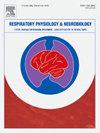基于ct呼吸道模型的BiPAP压力设置对气道生物力学的计算流体动力学分析。
IF 1.6
4区 医学
Q3 PHYSIOLOGY
引用次数: 0
摘要
中枢性和阻塞性睡眠呼吸暂停(CSA和OSA)、慢性阻塞性肺疾病(COPD)和肥胖低通气综合征(OHS)会扰乱呼吸模式,造成重大健康风险并降低生活质量。双水平气道正压(BiPAP)治疗提供可调节的吸入和呼出压力,潜在地增强了对上述疾病的治疗适应性。这是首次使用计算流体动力学(CFD)来检查BiPAP在四种设置下的生物力学影响的研究:吸气气道正压(IPAP)/呼气气道正压(EPAP)为12/8、16/6和18/8 cmH2O,与无BiPAP零表压的情况相比。利用从鼻腔延伸到第13代的基于计算机断层扫描的呼吸道模型,我们分析了不同气道区域的静压、剪切应力和气道壁法向力等参数。我们的研究结果表明,BiPAP,特别是在较高的IPAP设置下,有效地增加静压,从而改善气道通畅,并潜在地降低CSA和OSA患者气道塌陷的风险。另一方面,较低的EPAP有助于减少呼气过程中的呼吸功,这对于在较高压力下呼吸困难或需要更有效地呼出二氧化碳的患者特别有用。这一对比分析证实BiPAP不仅维持气道畅通,而且采用可调节的方法,可用于各种呼吸功能障碍患者的特定需求,从而提供了一种多功能和有效的治疗选择。本文章由计算机程序翻译,如有差异,请以英文原文为准。
A computational fluid dynamics analysis of BiPAP pressure settings on airway biomechanics using a CT-based respiratory tract model
Central and Obstructive Sleep Apnea (CSA and OSA), Chronic Obstructive Pulmonary Disease (COPD), and Obesity Hypoventilation Syndrome (OHS) disrupt breathing patterns, posing significant health risks and reducing the quality of life. Bilevel Positive Airway Pressure (BiPAP) therapy offers adjustable inhalation and exhalation pressures, potentially enhancing treatment adaptability for the above diseases. This is the first-ever study that employs Computational Fluid Dynamics (CFD) to examine the biomechanical impacts of BiPAP under four settings: Inspiratory Positive Airway Pressure (IPAP)/Expiratory Positive Airway Pressure (EPAP) of 12/8, 16/6, and 18/8 cmH2O, compared to a without-BiPAP scenario of zero-gauge pressure. Utilizing a computed-tomography-based respiratory tract model from the nasal cavity extending to the 13th generation, we analyzed parameters such as static pressure, shear stress, and airway wall normal force across different airway regions. Our results indicate that BiPAP, particularly at higher IPAP settings, effectively increases static pressure, thereby improving airway patency and potentially reducing the risk of airway collapse in both CSA and OSA. Lower EPAP, on the other hand, helps reduce the work of breathing during exhalation, which is particularly useful for patients who have difficulty exhaling against higher pressures or need to exhale CO2 more effectively. This comparative analysis confirms that BiPAP not only maintains open airways but does so with an adjustable approach that can be used for the specific needs of patients with various respiratory dysfunctions, thereby offering a versatile and effective treatment option.
求助全文
通过发布文献求助,成功后即可免费获取论文全文。
去求助
来源期刊
CiteScore
4.80
自引率
8.70%
发文量
104
审稿时长
54 days
期刊介绍:
Respiratory Physiology & Neurobiology (RESPNB) publishes original articles and invited reviews concerning physiology and pathophysiology of respiration in its broadest sense.
Although a special focus is on topics in neurobiology, high quality papers in respiratory molecular and cellular biology are also welcome, as are high-quality papers in traditional areas, such as:
-Mechanics of breathing-
Gas exchange and acid-base balance-
Respiration at rest and exercise-
Respiration in unusual conditions, like high or low pressure or changes of temperature, low ambient oxygen-
Embryonic and adult respiration-
Comparative respiratory physiology.
Papers on clinical aspects, original methods, as well as theoretical papers are also considered as long as they foster the understanding of respiratory physiology and pathophysiology.

 求助内容:
求助内容: 应助结果提醒方式:
应助结果提醒方式:


